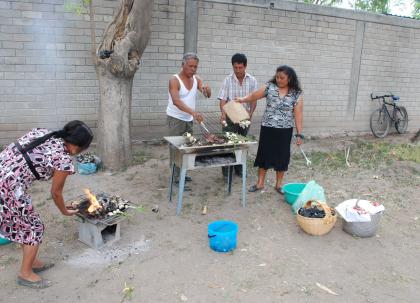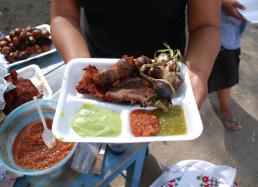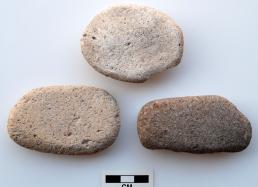8: A Get-together with the Crew
Last year, we found that one of the things that helped ease the transition from fieldwork to lab work was a final celebratory meal and get-together that we shared with our Mexican crew and some of their immediate families. This year, we decided to continue this tradition with our second fiesta, held the Saturday after completion of fieldwork. What makes this event a truly shared afternoon/evening is that, even though we contribute the bulk of the funds for the food and drink, all of the attending members of the crew contribute to the organization and preparation.
This season, we kept the menu similar to last year’s event and again focused on tasajo (thin strips of beef), cecina (strips of pork rubbed with chili powder), and chorizo (spicy Mexican sausage). All these meats were cooked over the grill (see above photo.) In traditional fashion, the meat, prepared over charcoal, was supplemented by grilled onions, guacamole, salsa, and, of course, tortillas.
Most Mexican meat, especially the beef that you can buy in villages, is grass fed. The animals are thin and so the meat can be a bit tough. But when prepared as thin strips of beef cooked over a grill, these local meats can be quite tasty. From the early afternoon and well into evening, we not only consumed large plates of food (see Photo #1 below), but also toasted the success of the fieldwork, intermixing humorous and ironic recollections of this year and last with our joint hopes for a future 2011 field season.
With our attention turning to the lab, we've also begun to welcome our analysts/specialists to Mitla. Lindsey arrived to begin the investigation of the recovered human bones, including burials, while Heather is due in Oaxaca soon to start her study of the faunal remains. A bit farther up the road, Jill will arrive to help with the scientific illustration of artifacts, particularly of chipped stone tools. Our dinner table is now fuller than when we began back in March.
For Linda and my part, when in the lab we first focus on the analysis of ceramic collections and then move to the few marine shell ornaments, and then to the stone tools (mostly chert, ground stone, and obsidian). When these analyses are completed, we'll turn our attention to the photographic documentation of significant artifacts of all material classes.
Since our collections ultimately remain in Mexico, recording key discoveries through scientific illustration and photography are essential parts of our laboratory procedure. For our North American crew, various kinds of map work, computer coding of data files, report preparation, checking, and ultimately packing are also regular stages of the post fieldwork operations. Meanwhile, Juan and Rolando have turned their efforts to cleaning, repairing, and organizing all of the supplies and equipment that we'll keep here over the next nine months.
As any archaeologist can tell you, cumulatively, the analysis and interpretation of data require far more time than we get to spend in the field. The lab and desk work are not ‘exciting’ enough to be amply discussed in popular and fictionalized accounts of the archaeological endeavor, but in reality, they're just as necessary to our efforts as the time spent in the field so that we can understand and create convincing and empirically supported accounts of the past.
And yet, when we can take a step back, have a few moments to breathe deeply, and compare the findings from several separate analyses, moments in the lab can be more exciting than they might seem. As Lindsey began to analyze the burials, she noted that one middle-aged woman had larger right hand and finger bones than left ones. She also had facets on her right finger bones indicative of repetitive use/work. The significant differences between this woman’s right and left hand bones indicated that the work was not simply the product of using a mano (a large ground stone tool employed to grind corn with two hands), but likely came from the heavy use of only one hand.
Intriguingly, before Lindsey noted this difference, Linda and I had observed a large number of abrading tools in the stone tool assemblage from Terrace 57. These abraders were small, hand-size, many flattened on one or more sides, with the flattened or abraded sides marked by thin linear impressions or striations from use (see Photo #2 below.) The striations on the tools were roughly the width of plant fibers and very likely came from the processing of ixtle (agave fiber). The abrading tools likely served to remove the last bits of pulp from the desired fiber.
Today, one variety of agave (Agave kerchovei), used solely for fiber in the past, is abundant on parts of the site (see Photo #3 below.) The woman with the much-used right hand may possibly have spent a good deal of her daily life extracting ixtle from dried agave fronds.
Word of the Day: the verb convivir, which means to “live together” or “to coexist.” Our Mitla crew refers to our end of fieldwork party as un convivio, or “a celebration of coexistence, working toward a shared goal.”
More soon,
Gary







